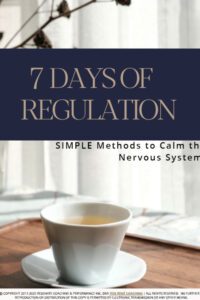Fear of Abandonment Series: PART 1
We’re diving into why this particular fear can’t be “thought through” and why mindset work will not work to tame this fear.
Table of Contents
The Body’s Response

When fear of being left hits, your body often reacts before your mind: muscles tighten, breath shortens, and safety feels far away.
“Your mind knows no one’s leaving, but your body doesn’t.”
Fear of abandonment hits hard because it moves through your body, not just your mind. Logic doesn’t help fear because your nervous system takes charge.
A delayed text or a sudden change in tone triggers you. You react fast, not because you’re dramatic, but because your body learned to brace for loss and your system jumps before your mind registers what’s happening.
Early conditioning teaches you to expect disconnection. You can’t out-think it; you must work through it with your body.
Fear anchors itself in your tissues. Warmth and attention loosen that grip. As your body discovers safety, your thoughts and emotions follow.
What Fear ‘Feels’ like:
Even when your mind knows no one’s leaving, your body still doubts it. You can tell yourself your friend still cares, your partner just needs space, and your colleague lost focus. Still, your body feels danger.
Your chest tightens, negative thoughts race, cortisol surges, and panic builds. Even when no one walks away, your body believes they will and you might hear:
“I’m too much.”
“They’re pulling away.”
“Something’s wrong.”
In those moments, there is nothing wrong with you. This is your sympathetic nervous system firing in an effort to protect you.
Fear of Abandonment Lives in Your Nervous System

Fear of abandonment isn’t only emotional it’s held in the body, stored in the nervous system’s survival response.
“Love is not stable. People are unpredictable.”
Fear of abandonment doesn’t form in your thoughts; it roots itself in your body as a survival response.
As children, when we experience people who show up emotionally and create safety, we learn two essential skills:
- Attunement: the ability to read another person’s emotions and respond with care.
- Co-regulation: the trust that we can steady ourselves by reaching for another person’s calm.
These early relationships teach your body that people can be safe, closeness soothes, and connection restores balance.
But when we grow up without consistent emotional attunement, love feels conditional or safety is unpredictable, the nervous system learns something very different:
Love is not stable. People are unpredictable. I have to monitor everything to stay safe (safety is in monitoring my environment, not connecting with others).
Often, this fear is rooted in early attachment wounds & experiences the inner child still carries in the body today. Even if your adult mind knows you’re safe now, your body might be living in a past where you weren’t.
This fear doesn’t just live in your thoughts it shows up as behaviour & physical symptoms.
Because you only received praise from your care-giver when you did something well, your young mind learned to equate love with doing well. Consequently, as an adult, you over-perform at work to keep earning your worth.
Other symptoms like:
-
Hypervigilance to tone of voice or text delays.
-
A racing heart when someone sets a boundary.
-
Urges to apologize or explain yourself or feeling like you’ve done something wrong.
- Frequent headaches and body aches you otherwise can’t account for.
Ready to calm your body’s alarm system?
Get my free guide: 7 Days of Regulation. Soothe your nervous system with these simple daily practices to help you feel calmer and more in control.
✦ I’m Ready to Regulate with Ease ✦ →
“Tess helped me move beyond fears I thought would always control me.” – Mila S
How Fear of Abandonment Hijacks the Present Moment

When fear takes over, the mind jumps to defend or plead pulling you out of connection and into old patterns.
“Better to brace for rejection than to be surprised by it.”
Your fear of abandonment nervous system isn’t trying to sabotage you, it’s trying to protect you.
When you experience an unstable connection to a caregiver, you learn that love is unpredictable. Consequently, your body learns to stay alert for signs of disconnection to help you avoid being hurt again.
Even in safe relationships, the nervous system may stay stuck in that old loop. Not being invited to a party may feel like a sign of neglect or being left out.
That early learning becomes a pattern of hyper-attunement, anxiety, or shutdown in adulthood.
Better to brace for rejection than to be surprised by it.
As a result, even healthy relationships feel tense. Emotional closeness becomes exhausting. You might feel needy, ashamed, or overwhelmed by your own reactions.
But here’s the truth: you’re not broken. Your body is remembering something it thinks is still true.
“Tess helped me understand why I reacted so strongly to things that didn’t seem like a big deal. It wasn’t just overthinking. It was my body, expecting loss. I finally feel like I have tools to work with my nervous system instead of fighting it.”
— Taylor P.
What Helps? Start with the Nervous System

Regulation begins by returning to the body; notice a gentle breath and grounded presence can coexist with discomfort.
“This is a body memory. I’m not actually in danger.”
You can’t think your way out of abandonment fear. However, you can teach your nervous system a new experience.
1. Naming and Accepting

Naming your emotion turns chaos into language helping you stop the fusion with emotions.
The next time the fear floods in, instead of rejecting it, accept the emotion is here. Simply ask yourself: Where do I feel this in my body?
Is it a tightening in your chest? A drop in your stomach? An urge to fawn or explain?
Just naming it begins the process of interrupting the loop.
Try saying out loud:
- “This is a body memory.”
- “I’m not in physical danger.”
- “This feeling is not who I am, but a temporary experience.”
Naming the emotional charge helps the body process it and accept what is in the current moment.
With time and practice, your body learns it doesn’t need to brace for abandonment. Your mind learns you can handle being with your emotions: they aren’t scary, they are messengers.
2. Interrupt the Alarm With Grounding

Grounding tells your body it’s safe now, the present moment doesn’t require past responses.
When your nervous system is overwhelmed, logic won’t land.
Instead, do something that calms your body:
-
Hold a warm mug and focus on the temperature
-
Press your feet gently into the floor
-
Use gentle touch—hand on heart, stroking your arms
These small actions signal safety to the part of you that still thinks you’re alone.
“Working with Tess was the first time I stopped blaming myself for being ‘too sensitive.’ She helped me understand that being wired for hypervigilance is not my fault actually helped me change that.”
— Dan S.
3. Let Your Body Experience Safe Repair

Healing happens through safe repair: moments that teach your body connection can coexist with safety.
The nervous system learns through experiencing something different. Because of this re-wiring, you will notice moments when someone doesn’t leave. You see when you’re met with kindness more often. And you allow yourself to be messy or quiet and still be loved.
These micro-moments of repair matter. Over time, they change the message from the part of you that always expected disconnection into one that expect connection.
This gives the space the body needs to build self-worth from the inside-out.
Final Thoughts
If your fear of abandonment nervous system still runs the show, you’re not broken; you’re wired for connection. It’s just the outdated alarm system going off which needs updating.
Healing starts with safety. Not just cognitive insight, but felt safety.
You can absolutely teach your body that connection is possible. That you’re not about to be left. That love can be something you soften into, not something you fight to keep.
Frequently Asked Questions
Q1. What do I feel anxious when things are going well?
That’s common. When you’ve lived in survival mode, calm feels untrustworthy. Therapeutic coaching helps you recognize anxiety as a protective pattern. You learn to help that pattern not identify with it or reject it.
Q2. How long does it take coaching to feel a difference?
Many clients notice a shift within a few sessions feeling more aware, and better able to respond instead of react. Healing deepens as you keep applying the tools between sessions and as we progress in your knowledge of yourself and your patterns.
Q1. How can coaching help with fear of abandonment?
Coaching helps you understand your triggers, unconscious patterns and build tools to meet your emotions with less fear or anxiety. My clients learn to create safety within themselves so connection no longer feels threatening.
Ready to Reclaim Your Calm?
You don’t have to keep bracing for loss.
When you’re ready to explore how this pattern affects your relationships, connect with me here.
✦ I’m Ready to Feel Secure in Connection ✦ →

Fear of Abandonment Series:

